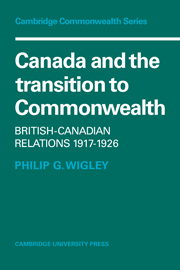Book contents
- Frontmatter
- Contents
- Abbreviations
- Preface
- Introduction
- 1 The threshold of responsibility, 1900–1916
- 2 New departures, 1917–1918
- 3 The settlement of peace, 1919
- 4 Unity and equality, 1919–1921
- 5 The centre cannot hold
- 6 Canadian diplomacy and Imperial diplomacy: 1923
- 7 From Lausanne to Locarno
- 8 The 1926 Imperial Conference: equality defined
- Conclusion
- Bibliography
- Index
6 - Canadian diplomacy and Imperial diplomacy: 1923
Published online by Cambridge University Press: 26 March 2010
- Frontmatter
- Contents
- Abbreviations
- Preface
- Introduction
- 1 The threshold of responsibility, 1900–1916
- 2 New departures, 1917–1918
- 3 The settlement of peace, 1919
- 4 Unity and equality, 1919–1921
- 5 The centre cannot hold
- 6 Canadian diplomacy and Imperial diplomacy: 1923
- 7 From Lausanne to Locarno
- 8 The 1926 Imperial Conference: equality defined
- Conclusion
- Bibliography
- Index
Summary
For Mackenzie King to establish a satisfactory degree of Canadian independence in foreign affairs there were two separate lines of action to be pursued. First and foremost it was necessary to disengage the dominion from any commitments to a united imperial foreign policy, and to secure its freedom of response to the international effects of that policy. But then in addition there should also be the possibility, as circumstances required, to undertake external commitments solely on Canada's own behalf. Before the dominion could lay claim to a functional autonomy in the empire–commonwealth, as a practical complement to its status, its authority in both these respects had to be demonstrated. The Chanak crisis, and the ignoring of overseas representation at the Lausanne Conference, had already precipitated a considered Canadian withdrawal from imperial responsibilities and imperial policymaking. In turn the opportunity to manifest the more individual side of Canadian diplomatic independence came in early 1923 with the completion of a halibut fishing treaty with the United States. Despite the opposition of the Foreign Office the treaty was signed by a Canadian minister and did not carry a British counter-signature, the first international agreement (albeit of a purely commercial nature) to be concluded in this manner. Yet although it has been remembered ever since for its unaccompanied Canadian signature, the Halibut treaty had repercussions in 1923 that went well beyond the question of diplomatic form, and contributed directly to a fundamental reappraisal of British policy towards the dominions.
- Type
- Chapter
- Information
- Canada and the Transition to CommonwealthBritish-Canadian Relations 1917–1926, pp. 173 - 205Publisher: Cambridge University PressPrint publication year: 1977



